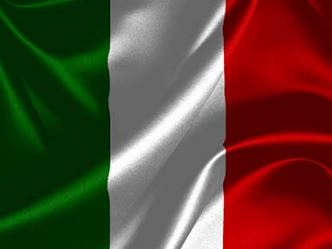Ostia Antica
About history
Ostia Antica is the excavation site of the ancient city of Ostia, the original port city of ancient Rome and possibly its first colony. The name Ostia derives from the Latin ostium "entrance; Mouth ", which means the mouth of the mouth. The name Ostia Antica (Old Ostia) is used to distinguish between the Ostia district, founded in the 1920s. The northeastern part of the modern district is also called Ostia Antica after the excavations. The theater is now at the Decumanus Maximus so now for geology. It is built of partial tuff rock see stairs.
Tuff (Italian tufo, of the same meaning Latin tofus) arises in case of a volcanic eruption due to fall deposits or flow deposits. In case of deposits, "volcanic rock fragments" are previously "glued" into the air. In the case of flow deposits, higher temperatures generally occur and the rock fragments are frequently melted. The color of the globally occurring tufa rocks ranges from gray to yellowish, brownish and reddish to strong red. Due to the volcanic gas inclusions, tuff is often very porous. It can therefore be easily edited, but, T. not very weather-resistant. Tuffs can be divided according to their structure:
• vitrical tuff with glass and pumice stone parts and fewer rock fragments
• lithographic tuff with prevalent rock fragments and less crystal or glass particles
• Crystal tuff with crystal fragments
In addition, they can be classified according to their chemical-mineralogical structure: therefore the color and structure of the tuff rock differs depending on what a rock has been transformed into tuff by volcanic activity.
Geology
According to the recommendation of the International Union of Geological Sciences (IUGS), a rock is referred to as tuff or ash tuff when it consists of 75% volcanic ash (<0.2 cm) (the rest can also consist of coarser components) and Total of more than 75% of pyroclasts (the rest can also consist of components of other rocks). However, the term "tuff" was used in general to a much broader extent, and indicated very simply solidified pyroclastic deposits of all grain sizes. Even in today's literature, tuff usually refers to a rock which consists not only of solidified volcanic ash, but also generally pyroclastic deposits of various grain sizes. The term tuff should therefore be used in combination with grain size or genetic labels.
Tuff - volcanic rocks
Deposits of glutlavins and ash streams, which solidified under the influence of water to rock, called tuff.
When gray volcanoes erupt, they eject volcanic loafers (tephra) in all sizes into the sky or they are components of the glut clouds or avalanches:
Ash, 0-2 mm
This rock dust consisting of particles less than 2 mm in size is ejected in large quantities. It forms gigantic ash clouds above the volcano. They can obscure the sky for an extended period of time because they do not transmit a sun beam.
Lapilli, 2 - 64 mm
Lapilli (Italian) means "pebbles". The tiny speckled lava particles are between 2 and 64 mm in size. They often rain down on the flanks of the volcano or are transported in the glutlavins with ash particles and can be discovered in the tuff.
Foreign rock fragments
In the ascent of the magma, bridges of the rocks in the vent are torn to the earth's surface. They are found in the tufts.
Characteristics of tuff
Color: yellowish, brownish, reddish
Information: Wikipedia / Federal Institute for Geosciences and Natural Resources
The entrance to Ostia Antica is subject to charges
In order to meet the regulations for Earthcaches, the following tasks must also be solved:
1. Describe in its own words the color and structure of the tufts used here.
2. Use the information from the listing to determine what kind of tuff it is.
3. Find evidence that the tuff rock used here is a porous and not very weather-resistant material.
The correct answers are then valid as log permissions! Send us these on our GC profile, then you can also log immediately! If something is wrong, we will contact you. We wish you a lot of fun on this geological discovery trip!

Ostia Antica
A proposito di storia
Ostia Antica è il sito di scavo dell'antica città di Ostia, il porto città originaria di Roma antica e forse la sua prima colonia. Il nome deriva dal latino ostium Ostia "di ingresso; Mouth", che significa la bocca della bocca. Il nome di Ostia Antica (Ostia antica) viene utilizzato per distinguere tra il quartiere Ostia, fondata nel 1920. La parte nord-orientale del quartiere moderno è così chiamato Ostia Antica dopo gli scavi. Il teatro è ora al vivo Decumano Massimo, come la geologia Registrati gratis. È costruito di tufo scale lago parziali.
Tufo (tufo italiano, dello stesso significato tofu latino) Nasce in caso di un'eruzione vulcanica causa della caduta dei depositi o flusso depositi. Nel caso di depositi, "frammenti di roccia vulcanica" sono precedenza "incollati" in aria. Nel caso di depositi di flusso, Temperature superiori gene raduno verificano ei frammenti di roccia sono spesso fuso. Il colore delle avvenuti globalmente tufo varia da grigio a giallastro, bruno rossastro e forte rosso. A causa delle inclusioni di gas vulcanici, tufo è spesso molto poroso. Può essere quindi facilmente modificati, ma, T. non è molto resistente agli agenti atmosferici. Tufi possono essere suddivisi gemäß alla loro struttura:
• tufo vitrical con parti in vetro e pietra pomice e un minor numero di frammenti di roccia
• tufo litografica con frammenti di roccia prevalenti e meno particelle di cristallo o vetro
• tufo cristallo con frammenti di cristallo
Inoltre, possono essere classificati Accor ding alla loro struttura chimica-mineralogica: i colori e la struttura della roccia di tufo è diversa a seconda che cosa una roccia è stato trasformato in tufo da attività vulcanica.
Geologia
Secondo la raccomandazione dell'Unione Internazionale delle Scienze Geologiche (IUGS), una roccia di cui è da come tufo o tufo cenere Quando si besteht del 75% cenere vulcanica (<0,2 cm) (il resto può quindi essere costituito da componenti più grossolani) e Total di oltre il 75% del materiale piroclastico (il resto può quindi essere costituito da componenti di altre rocce). Tuttavia, il termine "tufo" è stato utilizzato, in generale, in misura molto più ampia, e ha indicato depositi piroclastici in modo molto semplice solidificati di tutte le dimensioni di grano. Anche nella letteratura di oggi, tufo solito si riferisce a una roccia che besteht non solo di cenere vulcanica solidificata, così, ma i depositi gene raduno piroclastici di varie granulometrie. Il termine di tufo shoulderstand quindi essere utilizzato in combinazione con granulometria o le etichette genetiche.
Tufo - rocce vulcaniche
Depositi di glutlavins e torrenti di cenere, che solidifica sotto l'influenza di acqua al rock, chiamato tufo.
Quando i vulcani eruttano grigio, HANNO espellere mocassini vulcaniche (Tephra) in tutte le dimensioni verso il cielo o sono componenti delle nuvole glut o valanghe:
Ash, 0-2 mm
Questa polvere di roccia Composto particelle inferiore a 2 mm di dimensioni viene espulso in grandi quantità. Forma nubi di cenere gigantesche sopra il vulcano. Essi possono oscurare il cielo per in periodo di tempo prolungato perché non trasmettono un fascio di sole.
Lapilli, 2-64 mm
Lapilli (italiano) significa "sassolini". Le minuscole particelle di lava punteggiati sono tra 2 e 64 mm di dimensione. Essi spesso piovono sui fianchi del vulcano o trasportati nelle glutlavins con particelle di cenere e possono essere scoperti nel tufo.
frammenti di roccia Esteri
Nella risalita del magma, ponti di rocce nel sfiato sono strappati alla superficie della terra. Si trovano in ciuffi.
Caratteristiche del tufo
Colore: giallo, marrone, rossastro
Informazioni: Wikipedia / Istituto Federale per le Geoscienze e risorse naturali
L'ingresso a Ostia Antica è a pagamento
risolto al fine di rispondere ai requisiti per le cache della Terra, i seguenti compiti devono quindi essere:
1. Descrivere nelle sue stesse parole il colore e la struttura dei ciuffi utilizzati qui.
2. Utilizzare le informazioni dalla quotazione al mio deterministico che tipo di tufo è.
3. Trovare la prova ha fatto il tufo usato qui è un materiale resistente agli agenti atmosferici poroso e non molto.
Le risposte corrette sono quindi valide le autorizzazioni di registro! Inviaci tesi sul nostro profilo GC, quindi è possibile accedere in modo immediato! Se qualcosa non va, ti contatteremo. Vi auguriamo un sacco di divertimento in questo viaggio di scoperta geologica!

1. Beschreiben Sie in ihren eigenen Worten die Farbe und Struktur der hier verwendeten Tuffgestein ?
2. Verwenden Sie die Informationen aus der Liste, um festzustellen, welche Art von Tuff es ist ?
3. Finden Sie einen Nachweis, dass der hier verwendete Tuffstein poröses und nicht sehr witterungsbeständiges Material ist ?
